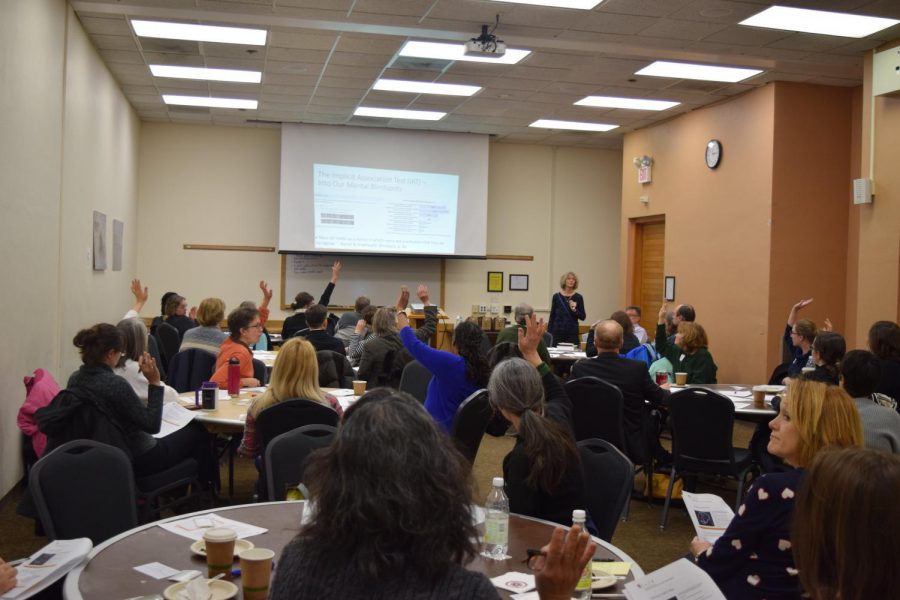“Biases. We often don’t recognize them, but we all have them. And these unconscious biases shape how we view and contribute to the world around us.”
This was the description of a workshop I attended at the Isenberg School of Management’s Inclusive Leadership Summit last weekend. The session focused on the widespread nature of implicit bias, drawing evidence from the results of Harvard University’s Implicit Association Test. The term “implicit bias” is frequently mentioned in a variety of contexts, from diversity and inclusion trainings at workplaces to conversations about police violence against people of color.
One presenter at this workshop made the statement that “with regular practice, we can all look past the surface.” What I gathered from this is that if we all just became more aware of our own biases, we could change them and treat people differently, thus creating a more inclusive and equitable environment. While this sounds nice, it is actually not a helpful way to look at bias because it treats bias as the root problem when it is actually a symptom of something larger.
Biases, whether positive or negative, did not just come about by accident. One 2018 paper traces current racial biases all the way back to slavery, with results indicating that they are the “cognitive residue of past and present structural inequities.” Once structures of unequal power and resources were put in place in the United States, certain beliefs had to be circulated to justify their continued existence.
While we have since formally dismantled the structure of slavery and instituted anti-discrimination legislation, our biases remain as byproducts of the beliefs that did, and still do, justify a power arrangement at the intersection of whiteness, capitalism and patriarchy.
Another reason why we must look beyond individualized notions of implicit bias is that there is some debate over the degree to which implicit bias is linked to actual behavior. Co-founder of the Implicit Association Test Brian Nosek points out that “You would think that if you change the associations, and the associations predict behavior, then the behavior would change too,” but the evidence to support this is limited.
A broader understanding of where bias comes from and who benefits from us having certain biases and not others can help us make sense of this finding. While we may all understand that it’s bad to have negative biases against certain groups of people, this does not prevent us from absorbing implicit and explicit societal messages that validate those biases. For instance, how often do we consciously consider the implications of Black people representing 60 percent of welfare recipients in the news and opinion media, despite working class whites being the biggest beneficiaries of government assistance? What messages are sent when advertisements and stock photos depict people of certain identities and not others in varying careers and in differing positions of authority? Such images are intentionally constructed to have a particular effect on viewers, and children in particular are highly vulnerable given their developing ability to interpret and make sense of reality.
A comparative example would be to expect everyone to stop eating junk food once they know that it’s bad for them. We would be remiss to ignore food companies’ concerted, intentional efforts to make junk foods irresistible and addictive, not to mention cheap and easily accessible.
Likewise, we cannot expect people to completely absolve themselves of implicit bias when our culture actively socializes us to embrace biases that maintain a status quo of preserving injustice.
Discussions of racial bias specifically are complicated by the fact that our current mainstream culture of purported “color blindness” outwardly denounces racism, yet provides no tools or language for us to critically and honestly examine how and why racial inequality persists. And bias against people of color has very real social consequences. It can be the difference between perceiving someone’s hair as natural and another’s as unprofessional. It can be the difference between seeing someone as assertive and someone as angry. And in the case of encounters with the police, it may be the difference between perceiving someone as running and someone as lunging, which can and has turned into the difference between life and death.
Awareness of and reflection on one’s implicit biases is a good first step, but biases must be understood within the context of larger systems, and not be used to divert attention away from their source in structures that preserve inequality. As philosopher Sally Haslanger says, “without structural change, cultural contestation, and redistribution of resources, the biases will persist and the most profound injustices will remain entrenched.”
Jennie Moss is a Collegian contributor and can be reached at [email protected].



















